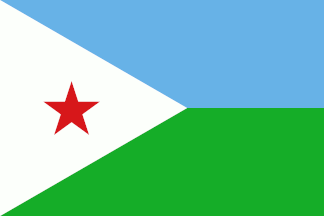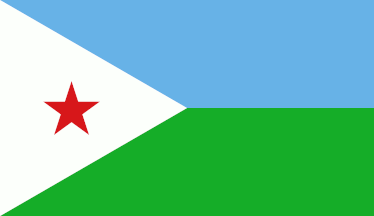
Last modified: 2025-04-19 by bruce berry
Keywords: djibouti | jibuti | peace | sea | star (red) | afars |
Links: FOTW homepage |
search |
disclaimer and copyright |
write us |
mirrors
 2:3
2:3  21:38
21:38 See also:
On the eve of independence in neighbouring Somalia in 1960 a referendum was held to decide whether or not to join the Somali Republic or remain under French administration. The result of the referendum was to continue the association with France. In 1966, France rejected a United Nation's recommendation that it should grant the territory independence and later in that year the then French President, Charles de Gaulle, visited French Somaliland and following a series of demonstrations, he called for a second referendum to be held on the future of the territory. Initial results supported a continued, but looser relationship, with France. Voting was divided along ethnic lines, with the resident Somalis generally voting for independence, with the goal of eventual reunion with Somalia, and the Afars largely opting to remain associated with France
In 1967, shortly after the referendum was held, the territory was renamed the Territoire français des Afars et des Issas (French Territory of the Afars and Issas). This was both in acknowledgement of the large Afar constituency and to downplay the significance of the Somali composition (the Issa being a Somali sub-clan). The structure of government was also amended with the position of Governor-General being changed to that of High Commissioner. A nine member council of government was also implemented.
On 27 June 1977 a third referendum took place on the
territory's constitutional future. A landslide 98.8% of the
electorate supported disengagement from France and the country became
independent as the Republic of Djibouti.
Martin Grieve, 26 Nov 2010
The national flag of Djibouti was designed by Mr. Mahamoud Harbi. The national emblem was designed by
Mr. Hassan Robleh, an artist. Source:
http://www.indexdjibouti.com/
Ivan Sache, 12 Aug 2002
The proportions of the flag are stated by Whitney Smith in Flags through the ages and
across the world (1975) [smi75b] as being approximately 21:38.
The colours are interpreted as being white for peace, blue for the sea and sky
and green for the earth. The
red star stands for unity. This flag has been used since 1972 by African National Liberation Union(?), and then the colours were interpreted differently. Green was for
the Afar
Muslims, and blue for Issas (also Muslims) who later joined with
Somalia. The flag was officially hoisted at
independence on 27 June 1977.
Željko Heimer 12 Dec 1995
I guess that the Constitution of Djibouti was drafted on the French model. The
"description" of the flag is as ambiguous as the description of the
French flag in the French Constitution. Which brings us no
nearer to the vexed question of what is the official ratio. Is it actually 21:38, or is
this as much of a vexillological myth as the Niger's 6:7?
Ivan Sache and Christopher Southworth, 10 April 2004
A note in Album des Pavillons (2000) [pay00] explains that the flag exists also in ratio 21:38. The
construction details are given as (2+2):(3~+3~) which isn't helpful. The star seems to be inscribed in a circle, 1/5 in diameter.
Other sources which I have consulted all give different ratios:
Flags and Arms across the World; Whitney Smith (1982) [smi82]
: 21:38~
Shipmate Flagchart [vdv98] : 1:2
Flags of the World, Nicole Smith (1995) [nsi95]
: 1:2 **
The World Encyclopedia of Flags, Alfred Znamierowski (1999) [zna99]
: 21:38 (but with a considerably bigger star).
I have a theory, that would give quite another ratio. Suppose that the rightmost angle of the triangle reaches the midpoint of the flag, so that the non-hoist sides of the triangle fall on the same line as the diagonals of the flag. That would make the whole rectangle twice as long as the equilateral triangle, and that is exactly square root of 3. That is, I "suggest" that the ratio is 1:sqrt(3), so approximately 100:173. This is not quite close to 1:2, nor 2:3, nor 21:38. So, there are 4 variations to this flag to be considered, but as far as I could see they only differ in the "length" of the blue and green stripes. The triangle is unaffected - always equilateral.
The colours are approximated in Album 2000 [pay00] as
:
blue Pantone 292c
green Pantone 361c
red Pantone 179c
Željko Heimer, 13 June 2001
The ratio of 21:38 is quoted by a variety of unconnected sources and so surely
must have a basis in fact somewhere? The only explanation I can come up with is
that the flag was originally defined by illustration or sample flag, and that
the artist or manufacturer intended the length to be twice that of the triangle.
A small drawing or manufacturing error would convert 21:36 into 21:38 would it
not?
Christopher Southworth, 01 Feb 2003
When working on Album 2000 [pay00], I
gave a ratio of 2:3. I relied on a sketch drawn in an official letter dated 22
July 1977 from the French Naval Authority at the time in Djibouti, the sketch
having exactly that ratio 2:3. I only mentioned ratio 21:38 in a note because of
the variations given in other vexillological books.
Armand du Payrat, 11 Feb 2003
The triangle in this flag is isosceles, but definitely not equilateral in my
source (and in many vexillological books).
Armand du Payrat, 12 Feb 2003
Decree #97-0163/PR/MI prescribes the details of implementation of the Friday 18
December election and of the next legislative election. In article 5 it is
noted: The ballot papers can be printed on coloured paper. [...] The combination
of the colours of the national flag is strictly prohibited on pain of a
1,000,000 to 2,000,000 FD fee for the printer. Source:
Website of
the Presidency of Djibouti.
In 1997, the exchange rate was 1 Euro ~ 200 FD.
Ivan Sache, 10 April 2004
The protocol manual for the London 2012 Olympics
(Flags and Anthems Manual, London, 2012 [loc12])
provides recommendations for national flag designs. Each National Olympic
Committee was sent an image of their flag, including the PMS shades, by the
London Organising Committee of the Olympic Games (LOCOG) for their approval.
Once this was obtained, the LOCOG produced a 60 x 90 cm version of the flag for
further approval. So, while these specifications may not be the official,
government, version of each flag, they are certainly what the National Olympic
Committee believed their flag to be.
For Djibouti : PMS 292 blue, 361 green, 032 red. The vertical flag is simply the
horizontal version turned 90 degrees clockwise.
Ian Sumner,
10 Oct 2012
The Presidency website has a page about symbols (https://www.presidence.dj/page/les-symboles),
but it only cites the text of the law issued in 2000 about the coat of arms.
The Kuwaiti Embassy of Djibouti website (https://djiboutiembassykuwait.net/en/p/index/36)
cites the relevant part of the constitution, and the 2000 law, and illustrates
the national flag and coat of arms. Flag ratio is 2:3.
There is a similar
introduction at Swiss Embassy website (http://www.djibouti.ch/ambassade/index.php/LaRepublique/EmblemesEtDrapeaux).
I haven’t found any legislation about its specification and colors.
Images show the flag with ratio 2:3 and with a longer ratio as well, probably
21:38, or simply with 1:2, the longer version is seen more often around high
officials. The white triangle seems to be equilateral.
Images of longer
flags:
https://www.mfa.gov.cn/eng
https://www.industrialization.go.ke
https://sudantribune.com
Other sources for colors:
The Flag Manual - Beijing 2008 gives Pantone
colors: PMS 179 (red), PMS 292 (blue), and PMS 361 (green).
The Album des
Pavillons 2000 [pay00] gives approximate colors
in Pantone and CMYK systems:
Blue: Pantone 292c, CMYK 70-25-0-0
Green:
Pantone 361c, CMYK 80-0-90-0
Red: Pantone 179c, CMYK 0-80-95-0
Illustration of flag with ratio 2:3~, and also mentioned 21:38.
Flags and
Anthems Manual London 2012 [loc12] gives Pantone colors: PMS 292 (blue), PMS 361
(green), and PMS 032 (red).
The Album des Pavillons 2023 specifies the
colors of the flags in three color systems.
Blue: Pantone 292c, CMYK
59-17-0-0, RGB 106-178-231
Red: Pantone 186c, CMYK 14-100-79-4, RGB 200-16-46
Green: Pantone 2271c, CMYK 78-0-100-0, RGB 18-173-43
Illustration of flag
with ratio 2:3, and mentioned 21:38.
Vexilla Mundi gives colors in Pantone
system: PMS 311C (blue), PMS 374C (green), PMS White, and PMS 199C (red). Ratio
unspecified, but the illustration is about 21:36.
Wikipedia gives the approximate color
values as follows:
Sky Light Blue: Pantone 284c, CMYK 59-11-0-0, RGB
106-178-231, Hex: #6AB2E7
Green: Pantone 354c, CMYK 77-0-100-0, RGB
18-173-43, Hex: #12AD2B
Red: Pantone 185c, CMYK 0-86-63-0, RGB 215-20-26,
Hex: #D7141A
White: Pantone White, CMYK 0-0-0-0, RGB 255-255-255, Hex:
#FFF FFF
Illustration of flag with ratio 2:3.
Flag Color Codes gives the following color
values:
Blue: Hex. # 6AB2E7, RGB 106-178-231, CMYK 55-13-0-0, Pantone
292, RAL 6027
White: Hex. # FFF FFF, RGB 255-255-255, CMYK 0-0-0-0,
Pantone N/A, RAL N/A
Red: Hex. # D7141A, RGB 215-20-26, CMYK 0-90-76-0,
Pantone 032, RAL 3028
Green: Hex. # 12AD2B, RGB 18-173-43, CMYK
68-0-100-0, Pantone 361, RAL 6038
Zoltan Horvath, 24 May 2024
.gif) Image
by
Zoltan Horvath, 24 May 2024
Image
by
Zoltan Horvath, 24 May 2024
Djibouti also has an emblem, which seems to have the same use as the seal of the
French Republic, i.e. sealing the official acts. The seal is of the same design
as the emblem, and its official meaning is explained in the law
prescribing it.
The "Loi n° 91/AN/00/4ème L portant définition du sceau de la République"
prescribes the seal of Djibouti. The French text of the law can be read on the
website of the Presidency of Djibouti:
http://www.presidence.dj/LES%20TEXTES/decr0163pr97.htm
Here is my English translation of the law:
Law #91/AN/00/4th L defining the seal of the Republic
The National Assembly has adopted
The President of the Republic promulgates
The law whose content follows:
In view of the 15 September 1992 Constitution;
In view of the 12 May 1999 Decree # 99-0059/PRE appointing the members of the
Government and stating their remits;
Article 1: The seal of the Republic of Djibouti shall be represented by a laurel
crown surrounding a shield and a lance surmounted by a five-pointed star. The
shield and the lance shall be flanked by two hands each holding a traditional
Djibouti dagger.
Article 2: The laurel crown shall represent peace granted to the Djibouti people
after the victory obtained during the attainment of independence on 27 June
1977. The shield, the lance and the star shall symbolize defence of the national
sovereignty and of the territorial integrity. The two traditional daggers held
by two hands shall symbolize the culture and traditions of the people as the
foundations of the National Solidarity.
Article 3: The seal shall be strictly reserved for the use by the President of
the Republic, the National Assembly and the Constitutional Council. The
President of the Republic can commission for its use the Minister of Foreign
Affairs and accredited Ambassadors.
Article 4: The present law shall be published in the Official Gazette of the
Republic of Djibouti as soon as promulgated and shall be enforced as a State
law.
Made in Djibouti, on 10 July 2000.
By the President of the Republic, head of the Government
Ismail Omar Guelleh
Ivan Sache, 10 April 2004